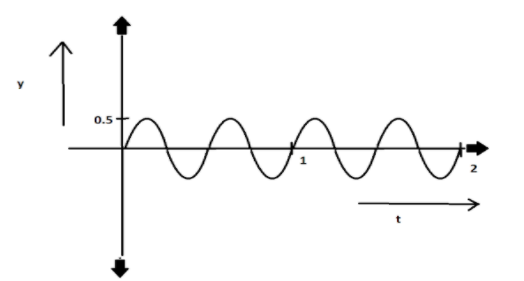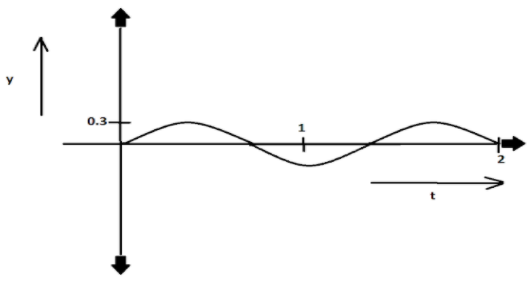
Which of the following figures represents a loud sound of low pitch?
Where $y = $ displacement $\left( m \right)$, $t = $ time $\left( s \right)$.
A)

B)

C)

D)

Answer
220.8k+ views
Hint: While solving any question related to loudness, we should remember that loudness is determined by the amplitude of the sound wave, and pitch is determined by the frequency of the sound wave. Also, the higher is the amplitude, the louder will be the sound and the lower is the frequency, the lower will be the pitch and vice versa.
Complete step by step solution:
Before answering the above question, we should know what is loudness and pitch of a sound.
PITCH: The pitch is the frequency of sound waves that the ear understands. A higher frequency sound has a higher pitch and a lower frequency sound has a lower pitch.
LOUDNESS: The loudness or volume of sound is determined by the amplitude of sound waves. The loudness of sound is directly proportional to the square of the amplitude. Hence, a louder sound will have a higher amplitude as compared to a softer sound.
Among option (A), option (B), option (C), and option (D), the graph in option (A) shows the highest amplitude and hence we can say it is the loudest among all, and option (D) shows the lowest amplitude and hence we can say it is the softest or the most silent among all.
Among option (A), option (B), option (C), and option (D) the graph in option (A) shows the least frequency, and hence we can say it has the least pitch among all, and option (C) shows the most frequency and hence we can say it has the highest pitch among all.
So we can clearly conclude option (A) satisfies our requirement of high loudness and low pitch.
Therefore, option (A) is the correct option.
Note: Keep in mind that the loudness of sound is dependent on the energy received by the ear per unit time. It is independent of the change in frequency. On the other hand, the pitch of the sound is independent of the energy received by the ear per unit of time. But, it is dependent on the frequency of sound, as with the increase in the frequency of sound shrillness of sound also increases.
Complete step by step solution:
Before answering the above question, we should know what is loudness and pitch of a sound.
PITCH: The pitch is the frequency of sound waves that the ear understands. A higher frequency sound has a higher pitch and a lower frequency sound has a lower pitch.
LOUDNESS: The loudness or volume of sound is determined by the amplitude of sound waves. The loudness of sound is directly proportional to the square of the amplitude. Hence, a louder sound will have a higher amplitude as compared to a softer sound.
Among option (A), option (B), option (C), and option (D), the graph in option (A) shows the highest amplitude and hence we can say it is the loudest among all, and option (D) shows the lowest amplitude and hence we can say it is the softest or the most silent among all.
Among option (A), option (B), option (C), and option (D) the graph in option (A) shows the least frequency, and hence we can say it has the least pitch among all, and option (C) shows the most frequency and hence we can say it has the highest pitch among all.
So we can clearly conclude option (A) satisfies our requirement of high loudness and low pitch.
Therefore, option (A) is the correct option.
Note: Keep in mind that the loudness of sound is dependent on the energy received by the ear per unit time. It is independent of the change in frequency. On the other hand, the pitch of the sound is independent of the energy received by the ear per unit of time. But, it is dependent on the frequency of sound, as with the increase in the frequency of sound shrillness of sound also increases.
Recently Updated Pages
Mass vs Weight: Key Differences Explained for Students

Electricity and Magnetism Explained: Key Concepts & Applications

JEE Energetics Important Concepts and Tips for Exam Preparation

JEE Isolation, Preparation and Properties of Non-metals Important Concepts and Tips for Exam Preparation

JEE Main 2021 July 25 Shift 1 Question Paper with Answer Key

JEE Main 2021 July 22 Shift 2 Question Paper with Answer Key

Trending doubts
JEE Main 2026: Application Form Open, Exam Dates, Syllabus, Eligibility & Question Papers

Understanding Uniform Acceleration in Physics

Derivation of Equation of Trajectory Explained for Students

Hybridisation in Chemistry – Concept, Types & Applications

Understanding the Angle of Deviation in a Prism

How to Convert a Galvanometer into an Ammeter or Voltmeter

Other Pages
Thermodynamics Class 11 Physics Chapter 11 CBSE Notes - 2025-26

JEE Advanced Marks vs Ranks 2025: Understanding Category-wise Qualifying Marks and Previous Year Cut-offs

Units And Measurements Class 11 Physics Chapter 1 CBSE Notes - 2025-26

NCERT Solutions For Class 11 Physics Chapter 8 Mechanical Properties Of Solids

Motion in a Straight Line Class 11 Physics Chapter 2 CBSE Notes - 2025-26

Laws of Motion Class 11 Physics Chapter 4 CBSE Notes - 2025-26




